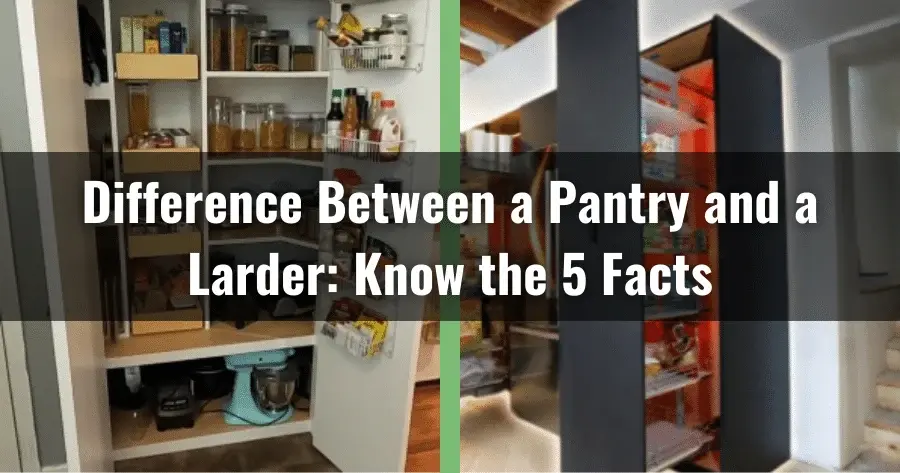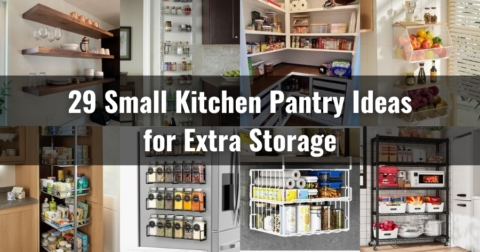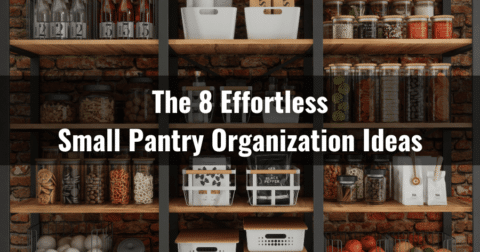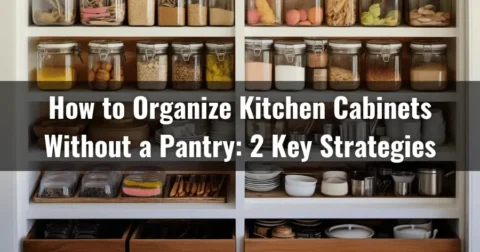The kitchen’s pantry and larder have crucial roles in storing and organizing food items. Both spaces are designed to meet different storage needs, each with its unique characteristics. But what are their differences?
Kitchen pantries are typically built-in storage areas within the kitchen itself, while larders are separate rooms or cupboards dedicated solely to food storage. Larders tend to be cooler because of their external location, whereas pantries tend to have more consistent temperatures.
Here we will discuss the major differences between a pantry & a larder and explore effective ways to organize and maintain them. So, keep reading if you’re ready to upgrade your kitchen storage game and make the most out of your pantry and larder spaces.
5 Key Differences Between a Pantry and a Larder
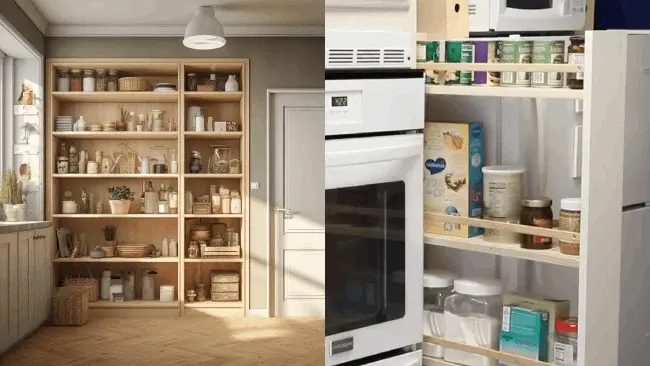
A pantry and a larder serve different purposes in your kitchen, so it is essential to understand the key differences. Here are the major points we have listed for you:
- Space and location
- Storage conditions and temperature
- Storage capacity
- Types of food stored
01. Space and Location
A pantry is typically a smaller room or cabinet within or near the kitchen. With modern technology, pantries are also sometimes separate walk-in spaces.
On the other hand, a larder is a larger, cooler storage area used to store perishable items.
Larders were often separate rooms located near the kitchen to keep foods at a controlled temperature. While modern homes are less likely to have a larder, some larger or more traditional kitchens might still feature them.
02. Storage Conditions and Temperature
You need to maintain the appropriate temperature in your pantry or larder for optimal storage conditions and freshness. In a pantry, where ambient temperatures are common, it’s best to store dry goods, canned items, spices, and non-perishable foods.
On the other hand, a larder traditionally had cooler temperatures to preserve perishable items. Modern larders may include refrigeration or remain as cool storage areas to maintain the freshness of your food.
03. Storage Capacity
Maximize your storage space by considering the storage capacity of your pantry and larder. Ensure you have enough room to keep all your essential non-perishable items and preserve perishable goods for an extended period.
Pantries offer ample storage space for a wide range of non-perishable items and kitchen essentials, making them convenient for everyday use.
04. Types of Food Stored
Regarding storing food, your pantry and larder each have their own unique selection of ingredients and products.
In your pantry, you’ll find:
- Dry ingredients such as flour, sugar, and rice
- Canned goods
- Baking supplies
- Snacks
- Sauces
- Spices
- Other non-perishable items
On the other hand, your larder is where you can store:
- Fresh produce like fruits and vegetables
- Dairy products like milk and cheese
- Occasionally cured meats.
The Concept of a Pantry in a Kitchen
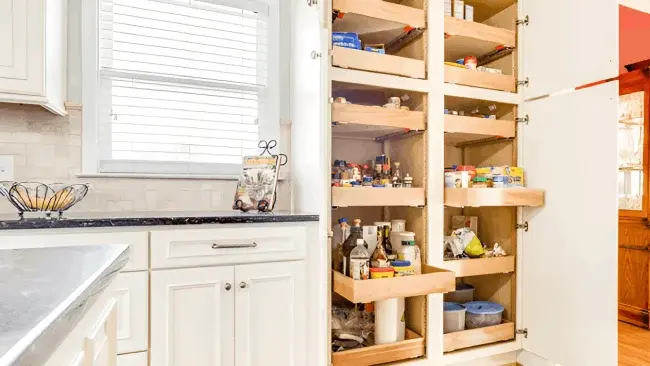
A pantry stands as a culinary sanctuary within a kitchen, meticulously crafted to accommodate an array of ingredients and essentials. Here’s an overview of the pantry:
i) Detailed Explanation of What a Pantry Is
Step into a well-stocked pantry, and you’ll find yourself surrounded by an abundance of carefully organized shelves, a true haven for all your cooking needs.
A pantry is a designated storage space in or near the kitchen, offering convenient access to frequently used ingredients and non-perishable items.
It typically includes adjustable shelves, drawers, and sometimes even countertop space. This allows for efficient organization of food supplies, making it easy to see what you have and quickly grab what you need while cooking.
ii) Various Types of Pantries
If you want to maximize your kitchen storage, consider adding a walk-in pantry. This pantry provides ample space for storing food items and kitchen essentials, allowing easy organization and access.
Another option is a pull-out pantry, a cabinet with shelves that can be pulled out for easy access to the contents.
Lastly, a butler’s pantry is a separate room or area adjacent to the kitchen, typically used for serving food and drinks during formal events.
iii) Typical Items Stored in a Pantry
A pantry is a storage space in the kitchen where you can find various commonly used food items. These include canned goods, pasta, rice, snacks, and spices. It is typically stocked with non-perishable items that have a longer shelf life.
Pantries are designed to provide easy access to ingredients for cooking and baking purposes. They help keep the kitchen organized and ensure that essential items are always on hand for meal preparation.
iv) The Benefits of Having a Pantry in a Kitchen
One major advantage of having a pantry in your kitchen is that it provides a convenient and organized space to store all your essential ingredients, making meal preparation much more efficient.
With a pantry, you can easily see what ingredients you have on hand and avoid buying duplicates. Also, having a designated storage area for your pantry items reduces clutter in the main kitchen area, creating a seamless cooking experience.
The Composition of a Larder in a Kitchen
Unlike a pantry, a larder in the kitchen serves a variety of purposes. Let’s know the larder in detail:
i) Detailed Explanation of What a Larder Is
In culinary storage, a larder is far from a mere pantry. It’s a versatile space that combines traditional cool storage with modern refrigeration options to keep perishable items fresh for extended periods.
A larder in the kitchen typically consists of multiple shelves and compartments designed to store various food items, including fruits, vegetables, dairy products, and meats. It provides an ideal environment with controlled temperature and humidity levels to extend the shelf life of these perishables.
Also, some larders may feature specialized drawers or racks specifically designed for storing wines or cheeses.
ii) Different Types of Traditional and Modern Larders
In this discussion, you’ll explore the traditional and modern types of larders.
- It’s used primarily for storing perishable food items traditionally at a cool temperature to prolong their freshness.
- Then, the hot larder serves as a space for keeping cooked dishes warm before serving.
- And finally, the freestanding larder or modern larder is a standalone piece of furniture that provides storage for a variety of pantry staples and kitchen essentials.
These different types of larders offer convenient storage options to help keep your kitchen organized and efficient.
iii) Typical Items Stored in a Larder
Larders are designed to store items that need to be kept cool or at a specific temperature.
You can expect to find a variety of fruits and vegetables, such as apples, oranges, lettuce, and carrots. Dairy products like milk, cheese, and butter are also commonly stored in larders.
For easy access, larders often store cured meats like bacon and salami. Additionally, you’ll find fresh baked goods in a well-stocked larder, such as bread and pastries.
iv) The Benefits of Having a Larder in a Kitchen
When you open the door of your larder, fresh produce, dairy delights, and delicious baked goods await you. It ensures better preservation of perishable goods, reducing food waste and saving money.
Separating storage areas for different food types encourages organization and easy access to ingredients when cooking.
Tips on How to Properly Organize and Maintain a Pantry and Larder
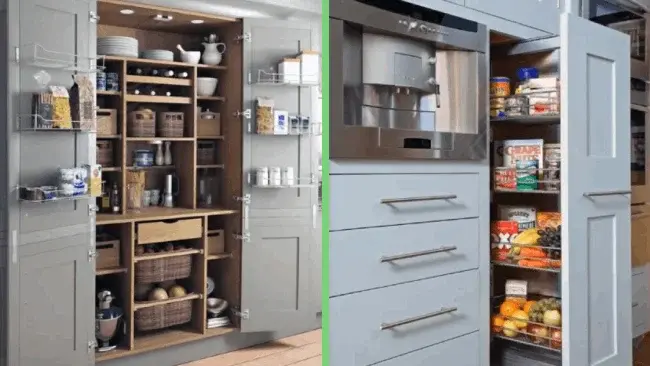
According to our extensive research, we listed here some tips on how do you organize and maintain your kitchen pantry and larder properly.
Effective Ways to Keep Pantry Organized
Transform your chaotic pantry into a well-organized oasis by implementing these effective tips:
- Categorize and label items for easy identification.
- Utilize storage containers and bins to keep small items organized.
- Arrange items based on the frequency of use, placing frequently accessed items at eye level. This ensures that everything is easily accessible and visible.
- Regularly clean out expired or unused items to maintain freshness and maximize space.
Crucial Steps to Maintain a Clean Larder
Following these steps will help you maintain a clean larder:
- Regularly clean and sanitize your larder to keep it free from pests and maintain the hygiene of your stored food. Remove all items from the larder and thoroughly clean the shelves using a mild detergent.
- Inspect the larder for any signs of pests or mold. If you find any contaminated items, discard them immediately to prevent further contamination.
- Once the larder is clean, organize your food items by category. This will make it easier to find what you need and help prevent cross-contamination.
- Label everything clearly, including expiration dates. This will ensure you can easily identify when items must be used or discarded.
- We highly recommend regularly checking for expired products and removing them from the larder. This will help prevent the consumption of expired food and reduce the risk of foodborne illnesses.
- Rotate perishable items to prevent food waste. Use the “first in, first out” rule to use the oldest items first and place newer items at the back. This will help ensure that nothing goes to waste.
Maximizing Storage Space in Both Pantry and Larder
One simple trick for getting the most out of your kitchen pantry and larder is to invest in stackable containers to optimize space efficiency. We believe these containers allow you to store items neatly on each other, using vertical space.
If necessary, consider installing additional shelves or hooks to maximize storage capacity. Pull-out drawers or lazy Susans are also great options for easy access to items at the back of your pantry or larder.
FAQ’S: Difference between a pantry and a larder
Here we listed some of the most commonly asked questions regarding pantry and larder for efficient kitchen management.
What is a hidden pantry called?
You may have wondered what a hidden pantry is called. Well, it’s referred to as a scullery or butler’s pantry.
These cleverly designed spaces are meant to be concealed or hidden from view. You can achieve this by using clever cabinetry where the door looks like a cupboard or by simply having a separate door to the room.
The main purpose of a scullery or butler’s pantry is to keep it discreet and out of sight in your kitchen design.
Is it OK to have a window in a pantry?
If you want a fully functional pantry, we suggest avoiding having a window that can take up storage space and potentially lead to issues with bugs and leaks.
While a window in the pantry might provide some natural light, it can also be a liability. It takes away valuable storage space that could be used for organizing your kitchen essentials.
Does a larder need ventilation?
To ensure your larder’s proper functionality, adequate ventilation through small windows covered in fine mesh is essential. This allows fresh air circulation while preventing insects or vermin from entering.
Placing the larder on the north or east side of your house, unless you have air conditioning installed, will help maintain a cool temperature. Proper ventilation is crucial for keeping your larder cool and free from unwanted pests.
But if you have modern kitchen larder cupboards, they are designed to be airtight and need no ventilation. The seals ensure the temperature stays the same and prevent insects from entering.
What height is a kitchen larder unit?
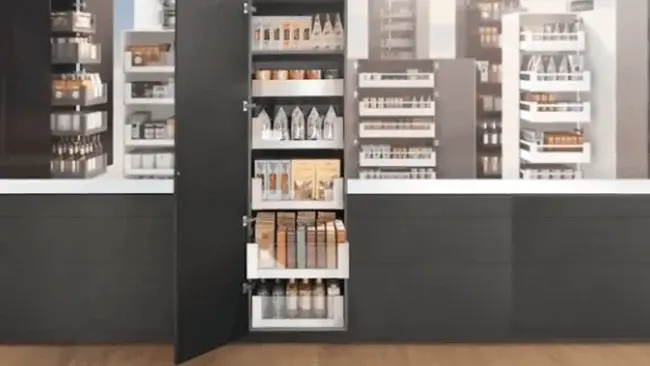
It is available in heights ranging from 1825mm to 2150mm (excluding the legs). The height of a kitchen larder unit can be chosen based on your needs and preferences.
Whether you have limited space or require ample storage, these units provide versatile options. You can customize your kitchen larder unit with various heights to suit your unique requirements.
Conclusion
Understanding the difference between a kitchen pantry and a larder is essential for efficient organization and maintenance. A pantry typically refers to a storage space for non-perishable food items, while a larder focuses on perishable food storage.
Properly organizing and maintaining your pantry and larder ensures that your kitchen remains well-stocked and organized.
Remember to regularly check expiration dates, label containers, and utilize storage solutions such as shelves and baskets. Following these tips will help you make the most of your pantry and larder spaces.

